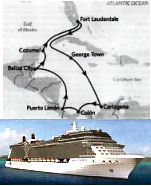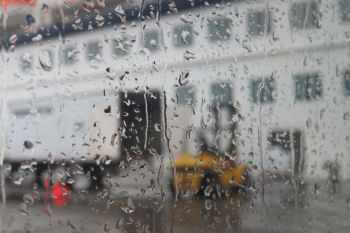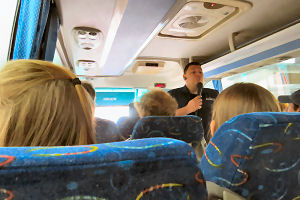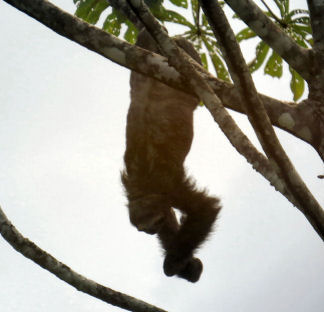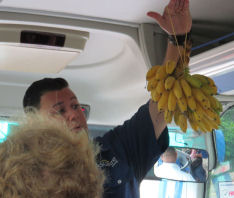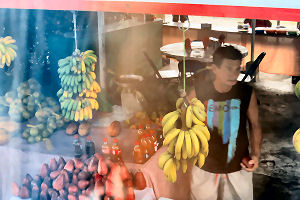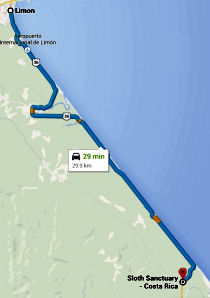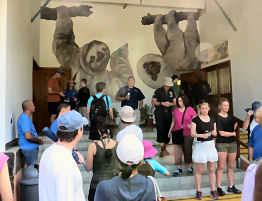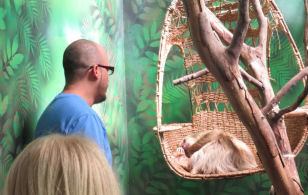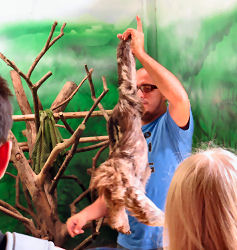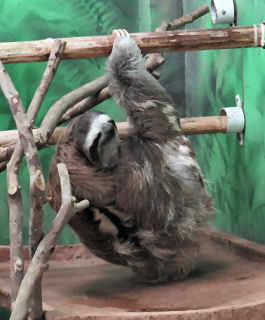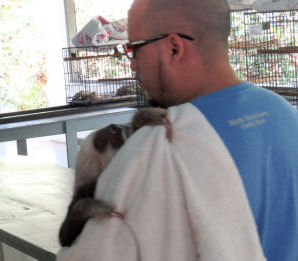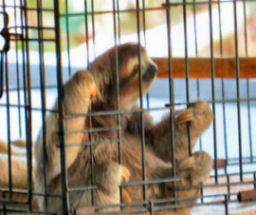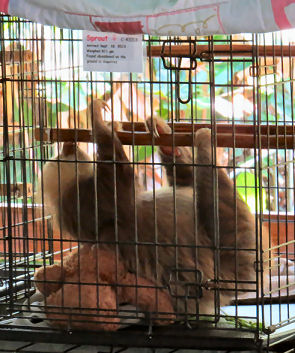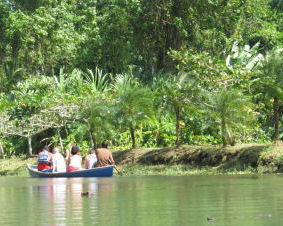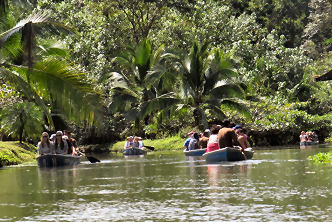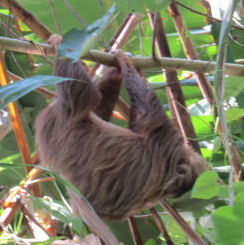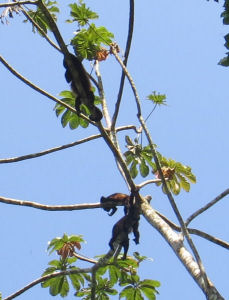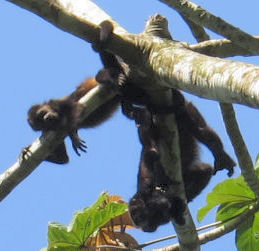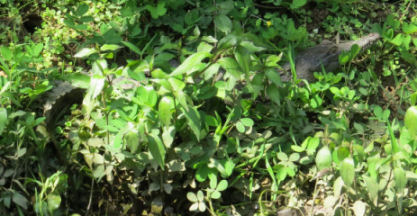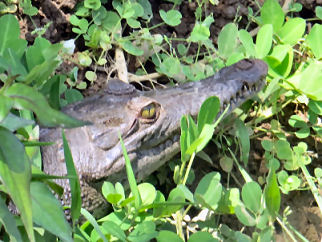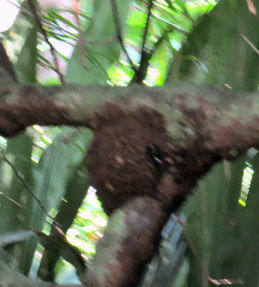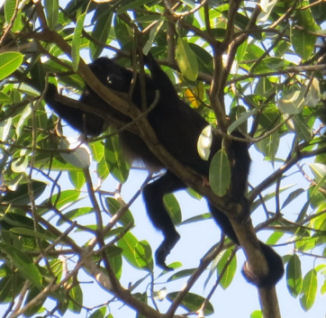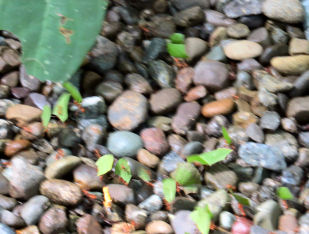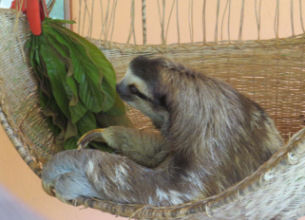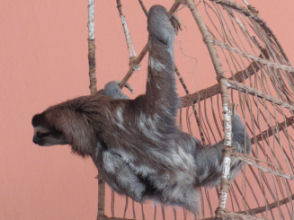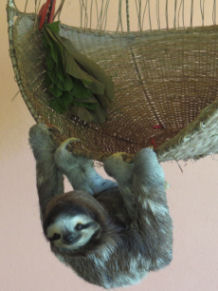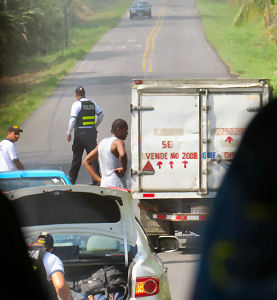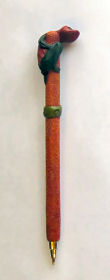The overnight passage between Colón and Puerto Limón, Costa Rica, seemed pretty smooth. By the time that Sue and I arose, the ship was already in port. I wasted no time because I had several chores to do before we departed for our excursion.
I checked my camera's battery immediately and found that it was fully charged. Sue then started downloading my photos to her computer.[1] While the computer was inhaling the photos, I checked my supply of underwear and socks. The underwear count seemed sufficient, but I was running out of short white socks. For some reason it had not occurred to me in frozen New England in December that I would want to wear shorts and sneakers every day. I washed three pairs out in the sink and used them to decorate the bathroom just before we left for breakfast.
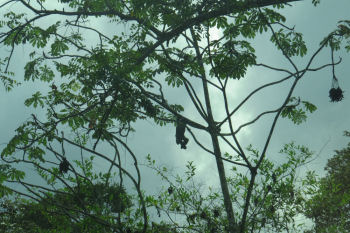
We were somewhat shocked to see that it was drizzling a little. What was this? Who ordered the rain? It never rains on my vacations.[2] Oh, well, the ship had provided each cabin with an umbrella. I stuffed it into my backpack before we headed down to the gangway.
The excursion in which we had enrolled for the stop in Costa Rica involved a visit to the Sloth Sanctuary. After the security people scanned our Sea Passes and allowed us onto the dock, we sought out the Sloth Sanctuary bus. The rain had decreased to a mist as we took our seats on the bus. A few minutes later it picked up again, and several people were worried about the weather.
Our guide Jonathan dismissed their concerns. He explained that it rained almost every morning in the rainforest region of Costa Rica. He introduced himself and Luis the bus driver and informed us that our destination, the Sloth Sanctuary, had been featured on Animal Planet several times. He also told us that although sloths resembled tree-dwelling primates in several ways, they were most closely related to anteaters and armadillos, neither of which ever left the surface.
Jonathan then made a very creditable public relations presentation for his home country. His command of English was absolutely impeccable. He began by informing us that fully one-quarter of his nation's land had been set aside for national parks. According to Jonathan, Costa Rica was responsible for 5 percent of the world's biodiversity.[3]
Costa Rica was proud of its incredibly small carbon footprint. Most of the people lived in the areas that require neither heat nor cooling. No hydrocarbons were used for generation of electricity; 85 percent of the electricity came from hydroelectric sources. 97 percent of the citizens had easy access to potable water.
Education in Costa Rica was free and mandatory for all children. They all learned to speak both Spanish and English. As a result Costa Rica – especially the capital city of San Jose, which is located in the central valley of the country – had long attracting large manufacturing and service concerns. Intel had been there for fourteen years and in 2014 employed 3,000 workers. Boston Scientific, which employed roughly the same number, developed the stent in Costa Rica as well as silicone implants. About 1,200 Costa Ricans worked in call centers for American companies. Almost all of these factories and offices were in and around San Jose.
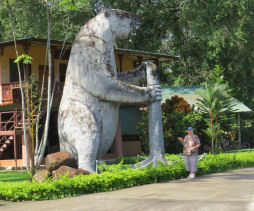
In fact, Costa Rica's top two businesses – tourism and manufacturing/service[4] – owe their development largely to the country's farsighted approach to education. From an economic point of view Costa Rica has left all of its neighbors in its dust.
A few minutes after the bus departed the pier area the sun came out. The rest of the day was delightful.
Luis did not choose the most direct route to the Sloth Sanctuary. He stopped once to direct our attention to a three-fingered sloth that he noticed was hanging from a branch of a tree within thirty yards of the road. He then made a stop at a stand at which people were selling fruit. Evidently nearly everyone in this area had some sort of fruit-producing garden. We were allowed to sample some delicious miniature bananas, and we got to see and touch water apples, star fruit, and chocolate before Luis turned the bus southeast down the coastline.
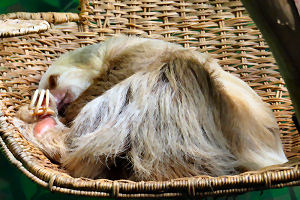
Incidentally, neither Jonathan nor anyone else whom we encountered ever claimed that Costa Rican bananas were better than the Panamanian ones. I had the strong suspicion that Costa Ricans of Jonathan's generation had moved beyond fruit-based rivalries.
Jonathan emphasized that his country's government had made a historic decision in 1820. It brought in Arabica coffee beans, considered by most to produce coffee of the highest quality, and gave property in the central valley near the capital of San Jose to married couples who pledged to raise coffee for twenty-five years. This proved to be a windfall both for the country and for most of the families that took advantage of the offer. It provided a firm basis for the country's subsequent economic evolution.
The downside to the region's rapid development was that it had now become overpopulated. 65 percent of the country's 4.9 million people lived there in 2014. The cost of living in that area dwarfed that of the rest of the country, but the people have continued to go where the jobs were. The minimum wage was $585 per month, but $1400-$2500 per month was considered middle class. Rents started at $500. The cost of electricity and water was not that much, and, of course, heating and cooling costs were trivial or non-existent. Just about everything else, however, cost much more than in the United States.
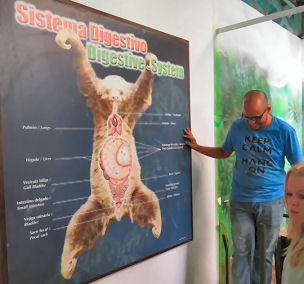
Automobiles were expensive, and gasoline costs $6.15 per gallon at a time when the price in the U.S. was below $2.00 in some places. Nevertheless, 80 percent of the people in San Jose owned cars. Jonathan reported that a seven-minute drive could take an hour and a half during rush hour. In response, the government had instituted a system of plate restrictions so that people could only use their cars every other day.
Most taxes were low, but property taxes were high. The income tax excluded the first $2500 earned. The sales tax was 13 percent. Most prices were regulated by the government.
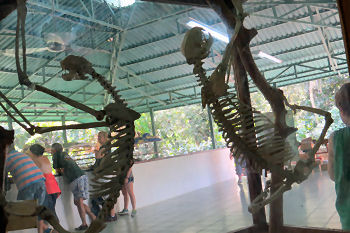
The currency of Costa Rica is called the colón. Roughly five hundred colónes make a dollar.
The rainy season is between May and October. Tourists ships abound during the other months.
We learned one other thing about Costa Rica: it had no army. The citizens did not seem to be too worried about being taken over by one of their well-armed neighbors. Go figure.
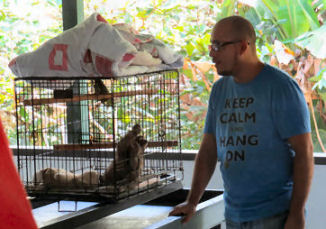
We arrived at the sanctuary after a trip of an hour and fifteen minutes. Most people used the restroom facilities, and then we split up into two groups for the introduction to the sloths. Our host was a young[5] man named Marco. He first showed us five adult sloths, all of which had been in the sanctuary for quite a long time. At the time of our visit the sanctuary had 140 sloths in residence. Most of them were probably there only temporarily. They would be released when they were ready.
Marco dispelled the notion that sloths were lazy, even though the name for the animal is equated with laziness in just about every language. Rather, sloths, which have been around a very long time, have a uniquely bad metabolism problem. Even though they are mammals in every sense, they are not exactly warm-blooded. They need the sunshine to stay warm. Even in the tropical paradise of Costa Rica they must conserve all of their energy just to keep themselves warm. They also exclusively consume foods that provide very little energy, and their complex digestive system takes a long time to extract energy from the food. The two non-extinct species[6] are both common in Costa Rica, despite the obvious handicaps. Their secret to survival is to stay up in the trees almost all of the time.
The first thing that we learned was how to distinguish two-fingered sloths from the three-fingered[7] ones. The two-fingered ones are roughly twice as large as the three-fingered species.
- The two-fingered sloths are brown, with some shading but no patches; the three-fingered ones are darker with white faces and black masking around their eyes. Three-fingered sloths sometimes have other markings as well.
- Two-fingered sloths are herbivorous, but their diet is somewhat varied. The three-fingered ones eat only a few different species of leaves.
- The hair of the two-fingered sloth is coarse; the three-fingered has soft and wavy hair.
- Both have round heads, but the two-fingered sloth has a protruding muzzle.
- The two-fingered sloth has much larger ears.
- Both have eighteen teeth, but four of the two-fingered sloth's are canines. Neither has incisors.
- The three-fingered sloth has nine cervical vertebrae, which allows it to turn its head an astonishing three hundred degrees. The two-fingered sloth has only five cervical vertebrae.
- The three-fingered sloth has no tail; the tail of the two-fingered sloth is about four inches long.
- The two-fingered's arms are roughly the same size as its legs; the three-fingered sloth's arms are nearly twice as long as its legs.
- The three-fingered sloth has only twenty-four ribs; the two-fingered sloth has forty-two.
- The three-fingered sloth has no external genitalia.
- The gestation period for a two-fingered sloth is eleven months. The three-fingered sloth's is not known; the estimate is six months.
- Two-fingered sloths are nocturnal; three-fingered ones can be active at any time of day.
- Three-fingered females attract mates by secreting pheromones; two-fingered sloths use calls.
In fact, the two species of sloth are not even in the same genus. Marco said that they are as closely related as cows are to horses. The now extinct megatherium, which reached a length of seven meters, is classified as a distant ancestor of the two-fingered sloth.
We met five adult sloths named Milly, Delilah, Johnny Depp, Tasmania, and Toyota. All but Toyota were two-fingered and extremely lethargic. Marco showed us the long hair on Milly's back and sides, which would help to drain water off of her body during the rainy season.
Delilah and Johny Depp had been brought to the sanctuary as infants. They had lived together since then in a Platonic relationship, although each had definitely exhibited interest in sloths of the other sex. Marco speculated that the reason for this peculiar relationship was that each considered the other as its parent.
Toyota had been electrocuted when he tried to hang from a power line in the rain. The affected arm had to be amputated. He has recovered, but he can never be released into the wild.
The most common causes for adult sloths to require help from the sanctuary were encounters with power lines, dogs, and hunting. The most common cause for juveniles were weather, predators, and abandonment by their mothers. Taking care of an infant requires a lot of effort on the part of a mother, and she does not have much energy to spare.
When the sanctuary releases sloths into the forest, it now provides the animals with backpacks that contain tracking devices so that their whereabouts and activities can be recorded. Sloths do not move around much. In general they stay in a tree for a week or so, come down to earth to go to the bathroom, find a new tree, and spend the next week aloft in it.
We next got to meet some baby sloths. Marco carried around Jemima, a three-fingered sloth to which he had developed a strong bond, and showed her to all of the tourists. We were not allowed to handle any of the sloths, but we got very good views of several of them.
Male sloths are not into the commitment thing; they split immediately after intercourse. Juveniles of both species spend the first year of their lives with their mothers. Only sloths that have lived through the entire process can survive in the wild. Therefore, if a sloth that is less than one-year old is brought to the sanctuary, it can never be released.
The next phase of the tour was a very slow canoe ride around a body of water that abutted the sanctuary. Sue and I were in the very first seat, and I was on the right, which meant that I was unable to extend my right leg at all. Eventually the tendinitis there caused me some rather annoying discomfort, especially when I twisted to try to photograph something.
We definitely heard some howler monkeys making all kinds of racket. They could not have been more than fifteen feet from the canoe. Nevertheless, I never saw them, but I occasionally detected movement of some bushes. We all saw a sloth in a tree, a different group of monkeys up in a tree, and a small crocodile.
Jonathan then led us on a short hike through the woods. Across the road we could see a troop of howler monkeys high up in the trees. Most of them appeared to be asleep. Jonathan also showed us an abandoned termite nest. The best part of the hike was when we came across a long line of leaf-cutter ants. The only bad part was when some bratty kids started to act up.
After the hike we were served some refreshments – pineapple, star fruit, melon, and papaya – and water to drink. We also got to meet Buttercup, the sanctuary's first resident and the friendliest sloth around. She put on quite a show.
The tour closed with a few minutes in the gift shop. I bought three bookmarks, mostly so that I would have some change for tips.
Sue and I could hardly believe our luck. All three of our excursions had been among the best that we had ever been on, and all three guides were absolutely excellent. We had hoped that the excursions would be a pleasant diversion from the bridge, but they had been so much more than that. All three had been extremely interesting, informative, and fun.
The bus arrived back at the pier at two o'clock. I was starving, but Sue wanted to spend some time shopping at the stores on the pier. I had somehow lost my last pen in the sanctuary, and I asked her to purchase one if possible.[8]
I ate lunch by myself in the café. Since I had a little time, I assembled a few dishes with a mildly oriental flair. They were all passable. Sue later told me that she had eaten a bratwurst with sauerkraut[9] at the Mast Grill.
I spent the rest of the afternoon getting some sun, reading Pirate Freedom by Gene Wolfe, and napping.
The whole gang was back together for supper. For some reason no one at the table seemed that interested in talking about the digestive systems[10] of various species of sloths. I concentrated on my beef bourguignon, which was delicious.
Sue and I only managed 44 percent in the evening game. After the game Marty asked me if we were playing together on Monnday afternoon. I explained that we had an excursion scheduled for Belize. He in turn explained that we would be at sea all day tomorrow. I had to admit that I was the one who was at sea, and I said that I would be happy to play with him.
Afterwards Sue and I found a place to sit that had much better lighting, and we went over the hands without the aid of overpriced liquor. Maybe we are making a little progress, but sometimes I wondered.
[1] Only one USB port on the Walmart back-to-school special still worked, and I needed that for the mouse.
[2] Actually, it has rained a few times, but it has never prevented me from doing anything. Check the journals if you don't believe me.
[3] I am not sure what this meant. Surely he did not mean that 5 percent of the species of flora and fauna were in Costa Rica and nowhere else. That hardly seems credible.
[4] Agriculture is third.
[5] At least by my standards.
